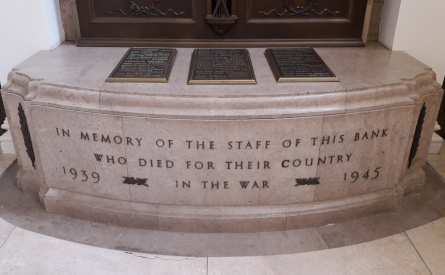
Our Second World War memorials
As they had done 25 years earlier, our banks remembered their lost staff with ceremonies, rolls of honour and war memorials.
When people erected war memorials in the aftermath of the First World War, they hoped and believed they were commemorating the war to end all wars. A generation later, however, those hopes were dashed. The world was again ripped apart by conflict, and by 1945 communities were once again facing the need to commemorate many thousands of lost lives. Just as they had done 25 years earlier, banks remembered their lost staff with ceremonies, rolls of honour and, of course, war memorials. This time, unlike in the aftermath of the First World War, there were established traditions and symbols of Remembrance for them to follow, adapt and build upon.
Royal Bank of Scotland
The Royal Bank of Scotland created a combined memorial for its head office at St Andrew Square in Edinburgh. Its First World War memorial had been built over a fireplace. It now added a stone plinth at the base, covering the grate, on top of which horizontal panels recorded the names of its Fallen from the Second World War.
The bank had grown since the First World War, including by the acquisition of the London-based bank Drummonds. The Second World War memorial thus included the names of four Drummonds men who died. Recognising that it might be difficult for their family members to attend the unveiling, which was held in Edinburgh in November 1951, the bank offered to pay for transport and overnight accommodation from London. For those who still could not attend, they sent copies of a printed brochure about the ceremony.
National Bank of Scotland
Other constituent banks adapted their First World War memorials to suit contemporary tastes. In the mid-1940s National Bank of Scotland rebuilt its head office, creating a modern, mid-20th century working environment. Its First World War memorial had been built into the fabric of the old head office building, making it hard to move, but its ornate style was also incongruous with the new building. The bank decided to discard its elaborate carved surround and keep only the simple name panel at its heart. The panel was also remade, so that it would match exactly a new panel for the Second World War.
The memorial was unveiled in 1954. At the same time a Roll of Honour was published, listing all the bank’s staff who had served in the war, as well as those who had died. Comparing this roll to the one published after the First World War reveals how the bank had changed in the intervening decades, as well as some differences between the two wars. The Second World War roll includes female staff who had served in the auxiliary forces, whereas the First World War roll lists no women’s names. There had been women in the bank in the earlier war, but their presence was treated as a temporary wartime measure; they were not official members of the permanent staff. Turning to the section commemorating those who had died, the pages show that fewer members of staff died in the Second World War, but among them – unlike in the First World War – were civilians killed as a result of enemy action. National Bank of Scotland, like many other banks, included these casualties in its war memorial.
Commercial Bank of Scotland
While other banks replicated the style of their existing war memorials, Commercial Bank of Scotland adopted a completely new design, entirely unlike its own First World War memorial as well as those erected by other banks. Designed by the noted Scottish architect Sir Frank Mears, it was constructed from pale stone and features a central figure of a soldier in bas-relief, the work of the sculptor Pilkington Jackson. This is the only war memorial from any of our constituent banks to depict a human figure, with the exception of an allegorical representation of Sacrifice as a woman on the Royal Bank of Scotland’s memorial.
On either side of the soldier figure, picked out in gold lettering, are the names of the bank’s Fallen, along with rank and regiment. By including these details of military service, the memorial continues a tradition begun by its First World War predecessor. Some other banks did the same, although more often just the names were given.
Westminster Bank
Not all of our banks centralised their commemorations with a single memorial in head office. Westminster Bank followed the pattern it had established after the First World War by placing a memorial in the last branch where each Fallen member of staff had worked. It was no simple task to ensure everyone was commemorated where they should be. In addition, many branches had taken on temporary staff, often on an informal or short-term basis. The bank did not keep full staff records for these workers, many of whom were teenaged boys who left to go on military service as soon as they were old enough. Many of them died, and to ensure they were included in the memorials, the bank had to rely on information from local managers, rather than central personnel records. This was a long process, but eventually the bank made and installed more than 140 memorials in branches and offices across the country.
The manufacture of so many memorials required resources, at a time when Britain still faced severe shortages as well as the urgent challenges of rebuilding for peacetime. Many banks struggled to source materials and labour to build their memorials, and Westminster Bank was no exception. It had discussed the question of commemoration shortly after the end of the war but took no further action for several years because of the difficulties obtaining materials. Its memorials, like those of our other banks, were not unveiled until the early 1950s.